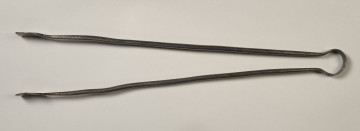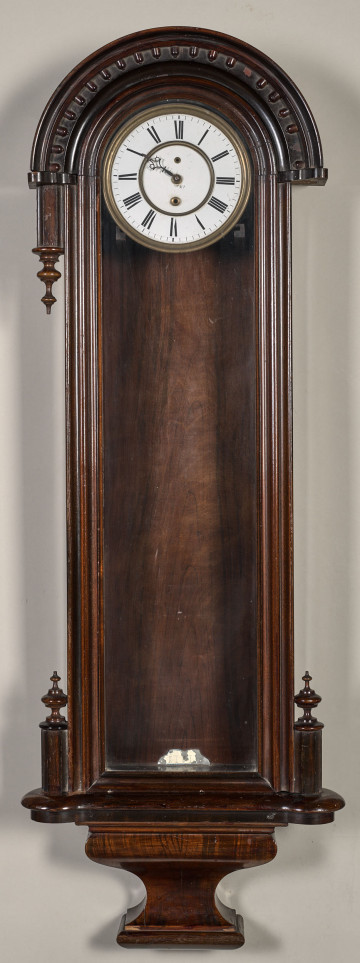
Fireplace tongs
Castle Museum in Łańcut
Part of the collection: Złotnictwo
Church chalice from the collection of the museum, made of silver, created by a gilder from Kraków bearing the initials LN in 1862. The chalice has a simple structure, and is made up of a bell-shaped cup proper, its edges slightly turned out; it also has a pear-shaped stem with a vase-like node and ring, as well as a profiled base. The ring is decorated with an overlaid geometric toothed ornament. The stem is connected to the base via a threaded screw hidden in the base. The cup is gilded inside and around the edge. The sole decoration of the chalice is the mentioned toothed ornament on the ring. The cup and base have gilder’s marks embossed on them. Presently, the chalice is stored at the castle chapel on the ground floor. The chalice is the oldest utensil used in liturgy during holy mass by the priest in the Roman ride, beside the paten. Since the middle ages, the rule has been to make the chalice out of gold or another precious material that does not corrode. If the chalice is made out of any other metal, then the interior of the cup is gilded. The name chalice originates from Greek and Latin, with the word kulix denoting an utensil to drink wine from. In Rome it gained a more slender form and was used for banquets. In the beginning, chalices were made of various materials. They were originally simple utensils made of wood, ceramic or glass. The times of the Carolingians brought about the unification of materials used to make chalices, and this process was continued by councils, to finally lead to the usage of just gold and silver. The shape of the chalice and its decoration also changed. Chalices were frequently richly decorated, not only in ornamentation but also figures of Christ, the saints or entire scenes from the life of Christ and saints. In the Roman period, chalices had a solid, strong form, and were richly decorated with figures and scenes. Gothic chalices were more slender, and the base took a four-, six- or multiple-leaf form. The most decorative part of Gothic chalices was the node, with the cup decorated in the form of a basket. In later times, the cup itself became smaller in the basket, with the entire chalice ornamented. In the 18th century chalices appeared that were entirely devoid of decorations. The 19th century, during the time of revival of historic styles, Gothic inspirations returned. Starting in the 20th century, until now, chalices are shaped more simply, with decorations almost completely abandoned.
Dimensions
height: 23.6 cm
Object type
goldsmithing
Technique
mill forming
Material
silver
Creation time / dating
Creation / finding place
Owner
Castle Museum in Łańcut
Identification number
Location / status

Castle Museum in Łańcut

19th (?) century
Castle Museum in Łańcut

19th (?) century
Castle Museum in Łańcut
DISCOVER this TOPIC
Museum of King Jan III's Palace at Wilanów
DISCOVER this PATH
Educational path